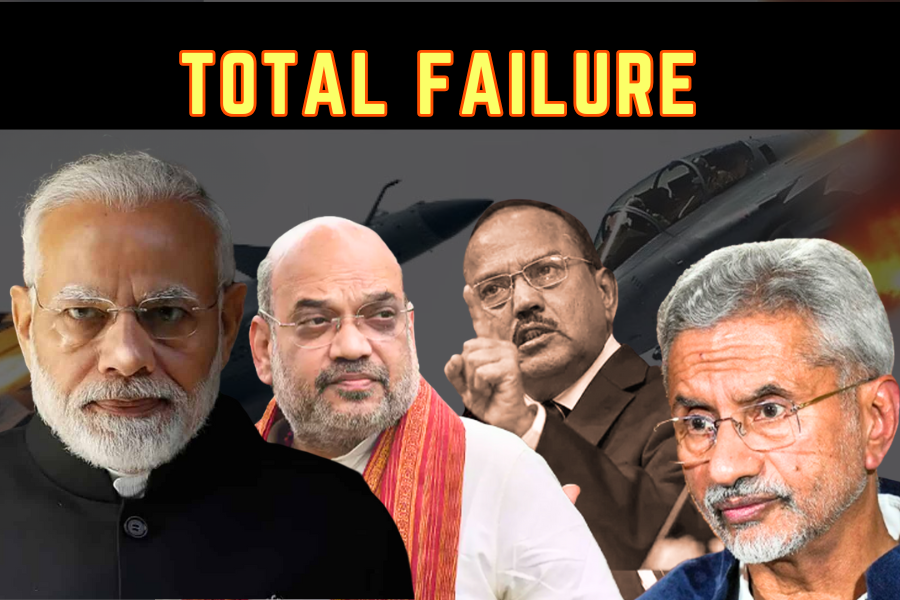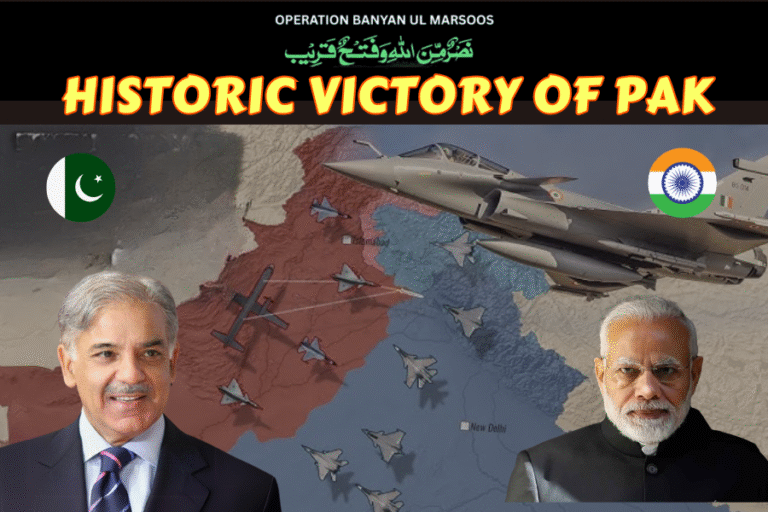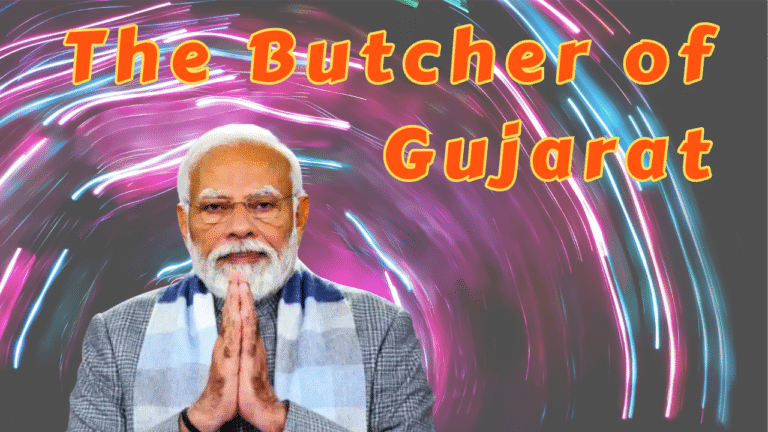(By Khalid Masood)
In the annals of South Asian geopolitics, the Indo-Pak crisis of May 2025 stands as a stark testament to India’s strategic and diplomatic collapse. Triggered by the April 22, 2025, Pahalgam terrorist attack, India’s response—from intelligence failures to military blunders and diplomatic overreach—unraveled into a series of catastrophic missteps. This article, crafted with the precision of English prose, the nuance of diplomacy, and the rigor of military strategy, dissects India’s “total failure” across security, military, and diplomatic domains. From a Pakistani perspective, it underscores Pakistan’s resilience and tactical superiority, reshaping the regional power dynamic and exposing India’s hubris on the global stage.
1. The Pahalgam Prelude: A Failure of Prevention
On April 22, 2025, a terrorist attack in Pahalgam, Jammu and Kashmir, claimed 26 civilian lives, mostly tourists (The Hindu, May 7, 2025). India’s initial failures were glaring. Intelligence agencies, despite prior tips from unspecified sources, failed to preempt the assault (Reuters, May 9, 2025). Security arrangements for tourists, a vital economic lifeline, were woefully inadequate, with no visible patrols or checkpoints in the area (Al Jazeera, May 14, 2025). Most damningly, medical response was absent for hours, leaving victims to perish unaided, a lapse that sparked outrage on X, with @RaoofHasan decrying India’s “callous neglect” (X, May 27, 2025). The perpetrators escaped, untracked and unpunished, highlighting India’s inability to neutralize threats on its soil (CNN, May 7, 2025). These lapses set the stage for India’s cascading failures.
2. Hasty Accusations: Diplomatic Miscalculation
India’s immediate response was to pin the blame on Pakistan, alleging sponsorship by Lashkar-e-Taiba and Jaish-e-Mohammed without evidence or inquiry (The Times of India, May 13, 2025). Prime Minister Narendra Modi’s rhetoric, amplified by media, assumed global condemnation of Pakistan would follow (The Guardian, May 12, 2025). Yet, not a single nation endorsed India’s narrative. Pakistan, alongside China, the UAE, and others, condemned the civilian deaths while rejecting India’s accusations (CNN, May 11, 2025). Pakistan’s call for a neutral third-party investigation, supported by the UN and EU, exposed India’s refusal as arrogant and isolating (Reuters, May 10, 2025). X user @sherryrehman noted, “India’s blame game collapsed under scrutiny” (X, May 28, 2025). India’s diplomatic gambit faltered, undermining its credibility.
3. UN Security Council Setback: A Global Rebuke
At the UN Security Council, India initially succeeded in including Pakistan’s name in a draft resolution condemning the Pahalgam attack (The Hindu, May 8, 2025). However, Pakistan’s deft diplomacy, led by Foreign Minister Bilawal Bhutto Zardari, secured the removal of its name and accusatory language (Al Jazeera, May 14, 2025). All permanent members—China, Russia, the U.S., UK, and France—alongside non-permanent members, endorsed Pakistan’s position, prioritizing a neutral probe over India’s unilateral claims (Reuters, May 10, 2025). This unanimous rejection was a diplomatic rout for India, with @AbdullahKhan333 on X calling it “India’s UNSC humiliation” (X, May 27, 2025). India’s failure to rally global support underscored its strategic misjudgment.
4. Failed Bilateral Outreach: A Deafening Silence
In a frantic bid to isolate Pakistan, Modi, Foreign Minister S. Jaishankar, and National Security Advisor Ajit Doval made phone calls to leaders in the U.S., France, UAE, and other allies, urging condemnation of Pakistan (The Times of India, May 12, 2025). Not one country complied, with even close partners like the U.S. emphasizing de-escalation (CNN, May 7, 2025). U.S. Vice President J.D. Vance’s refusal to blame Pakistan during his India visit further highlighted India’s isolation (Al Jazeera, May 14, 2025). The silence from allies proved India’s narrative was hollow. India’s diplomatic overtures, steeped in expectation, crumbled under global skepticism.
5. Media Warfare Flop: Pakistan’s Defiant Humor
India unleashed a media and social media blitz to intimidate Pakistan, with outlets like Republic TV and Zee News amplifying jingoistic rhetoric (The Wire, 2024). However, Pakistanis remained undeterred, countering with humor and defiance. Hundreds of funny memes mocking India’s belligerence flooded on X, Facebook and TikTok. This social media resilience, lauded by global observers, showcased Pakistan’s psychological strength (The Diplomat, May 7, 2025). India’s attempt to cow Pakistan through propaganda backfired, cementing its image as a blustering giant.
6. Operation Sindoor: A Military Debacle
On the night of May 6–7, 2025, India launched Operation Sindoor, a massive air assault targeting nine sites in Pakistan and Azad Kashmir (Carnegie Endowment, May 7, 2025). The Indian Air Force (IAF) deployed 72 aircraft, including Rafales, Su-30MKIs, and MiG-29s, aiming to destroy alleged terrorist infrastructure (The Times of India, May 13, 2025). The Pakistan Air Force (PAF), with 42 J-10C and JF-17 Block III jets, responded decisively, downing six IAF aircraft—three Rafales, one Su-30MKI, one MiG-29, and one Mirage 2000—using PL-15E missiles (Reuters, May 9, 2025; 19FortyFive, May 10, 2025). The losses, confirmed by crash sites and pilot conditions, shook IAF confidence, leading to the grounding of its fleet and retreat to rear bases (Al Jazeera, May 14, 2025). India’s military failure was absolute, its deterrence shattered.
7. Drone and S-400 Fiascos: Technological Humiliation
On May 8, India deployed a fleet of Israeli-made Heron drones to penetrate Pakistani airspace, aiming to gather intelligence or provoke (The Aviationist, May 7, 2025). Pakistan neutralized all drones using electronic countermeasures (ECM) and ground-based gunfire, with no losses (Missile Matters, May 8, 2025). On May 9, Pakistan escalated, using hypersonic missiles fired from JF-17 jets to destroy an Indian S-400 AD system, exposing its vulnerability (Bulgarian Military, May 7, 2025). The S-400, a $5.4 billion acquisition, failed to protect itself, marking another Indian technological debacle (Neue Zürcher Zeitung, May 7, 2025). These failures underscored Pakistan’s superior tactics and India’s overreliance on costly imports.
8. Pakistan’s Counteroffensive: Shattering Indian Confidence
On May 10, Pakistan launched a devastating counteroffensive called Operation Bunyan Al Marsoos, targeting 36 Indian airbases, missile dumps, and military sites with precision strikes (The Diplomat, May 7, 2025). Pakistani Military Command’s aim was to “pulverize” India’s military infrastructure, shattering its confidence (19FortyFive, May 10, 2025). The operation succeeded after creating havoc from Kashmir to Runn of Kutch, forcing India to seek international mediation to halt escalation (CNN, May 11, 2025). Indian leaders, including Modi and Jaishankar, contacted the U.S., China, and UAE, pleading for de-escalation, a stark admission of defeat (Reuters, May 13, 2025). Pakistan’s strategic triumph, as @PakDefTeam noted on X, “rewrote South Asia’s power equation” (X, May 22, 2025). India’s military hubris lay in ruins.
9. Post-Ceasefire Narratives: A Web of Contradictions
After the May 12 ceasefire, India struggled to salvage its image with conflicting narratives (The Times of India, May 12, 2025). Jaishankar claimed India informed Pakistan before the May 6–7 attack, then contradicted himself, saying notification came 30 minutes post-strike (Al Jazeera, May 14, 2025). Such inconsistencies, mocked on X by @OmerAzhar96 as “India’s diplomatic comedy,” eroded credibility (X, May 28, 2025). India dispatched parliamentary and diplomatic delegations to global capitals, spending millions to push its terrorism narrative against Pakistan (The Hindu, May 8, 2025). Yet, no major leader met these groups, relegating them to second- and third-tier officials (Reuters, May 10, 2025). India’s global lobbying, like its military and diplomatic efforts, was a resounding failure.
10. Conclusion: A Legacy of Hubris and Defeat
India’s response to the 2025 Pahalgam attack—from intelligence lapses to military defeats and diplomatic isolation—embodies a saga of total failure. Its inability to protect citizens, neutralize threats, or rally global support exposed strategic and moral bankruptcy. The PAF’s downing of six IAF jets, neutralization of Heron drones, and destruction of the S-400 system underscored Pakistan’s tactical superiority (19FortyFive, May 10, 2025). Pakistan’s counteroffensive on May 10 and deft diplomacy at the UNSC cemented its resilience, echoing the spirit of Youm-e-Takbeer (Dawn, 1998). India’s jingoistic rhetoric, epitomized by Modi’s “bullet” threat, crumbled against Pakistan’s resolve (Al Jazeera, May 12, 2025). As Quaid-e-Azam Muhammad Ali Jinnah said, “We are a nation with our own distinctive culture and civilization” (Speech, 1947). Pakistan’s triumph in 2025 reaffirms this, while India’s failures serve as a cautionary tale of hubris in statecraft.
__________________________
Sources: The Hindu, May 7-8, 2025; Reuters, May 9-13, 2025; Al Jazeera, May 12-14, 2025; CNN, May 7-11, 2025; The Guardian, May 12, 2025; The Times of India, May 12-13, 2025; The Wire, 2024; 19FortyFive, May 10, 2025; Missile Matters, May 8, 2025; Bulgarian Military, May 7, 2025; The Aviationist, May 7, 2025; Neue Zürcher Zeitung, May 7, 2025; The Diplomat, May 7, 2025; Carnegie Endowment, May 7, 2025; Dawn, 1998; X, May 10-28, 2025.







